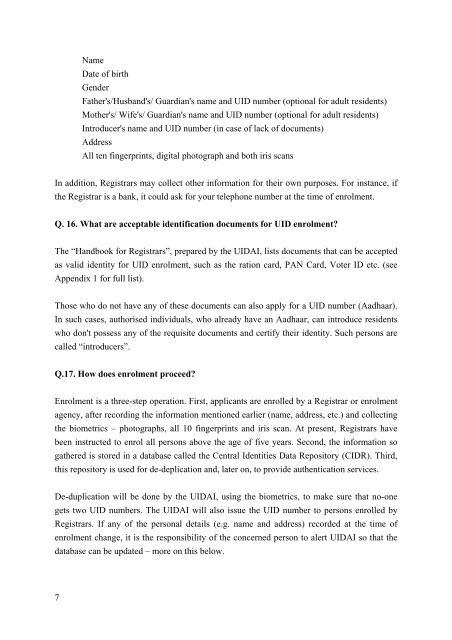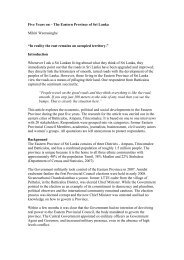UID For Dummies (PDF) - Countercurrents.org
UID For Dummies (PDF) - Countercurrents.org
UID For Dummies (PDF) - Countercurrents.org
Create successful ePaper yourself
Turn your PDF publications into a flip-book with our unique Google optimized e-Paper software.
Name<br />
Date of birth<br />
Gender<br />
Father's/Husband's/ Guardian's name and <strong>UID</strong> number (optional for adult residents)<br />
Mother's/ Wife's/ Guardian's name and <strong>UID</strong> number (optional for adult residents)<br />
Introducer's name and <strong>UID</strong> number (in case of lack of documents)<br />
Address<br />
All ten fingerprints, digital photograph and both iris scans<br />
In addition, Registrars may collect other information for their own purposes. <strong>For</strong> instance, if<br />
the Registrar is a bank, it could ask for your telephone number at the time of enrolment.<br />
Q. 16. What are acceptable identification documents for <strong>UID</strong> enrolment?<br />
The “Handbook for Registrars”, prepared by the <strong>UID</strong>AI, lists documents that can be accepted<br />
as valid identity for <strong>UID</strong> enrolment, such as the ration card, PAN Card, Voter ID etc. (see<br />
Appendix 1 for full list).<br />
Those who do not have any of these documents can also apply for a <strong>UID</strong> number (Aadhaar).<br />
In such cases, authorised individuals, who already have an Aadhaar, can introduce residents<br />
who don't possess any of the requisite documents and certify their identity. Such persons are<br />
called “introducers”.<br />
Q.17. How does enrolment proceed?<br />
Enrolment is a three-step operation. First, applicants are enrolled by a Registrar or enrolment<br />
agency, after recording the information mentioned earlier (name, address, etc.) and collecting<br />
the biometrics – photographs, all 10 fingerprints and iris scan. At present, Registrars have<br />
been instructed to enrol all persons above the age of five years. Second, the information so<br />
gathered is stored in a database called the Central Identities Data Repository (CIDR). Third,<br />
this repository is used for de-deplication and, later on, to provide authentication services.<br />
De-duplication will be done by the <strong>UID</strong>AI, using the biometrics, to make sure that no-one<br />
gets two <strong>UID</strong> numbers. The <strong>UID</strong>AI will also issue the <strong>UID</strong> number to persons enrolled by<br />
Registrars. If any of the personal details (e.g. name and address) recorded at the time of<br />
enrolment change, it is the responsibility of the concerned person to alert <strong>UID</strong>AI so that the<br />
database can be updated – more on this below.<br />
7










